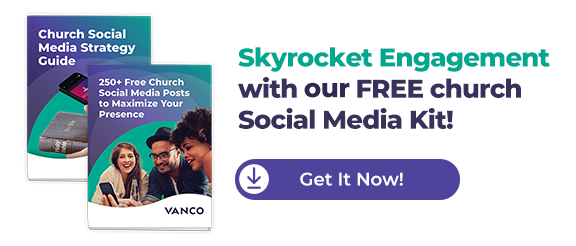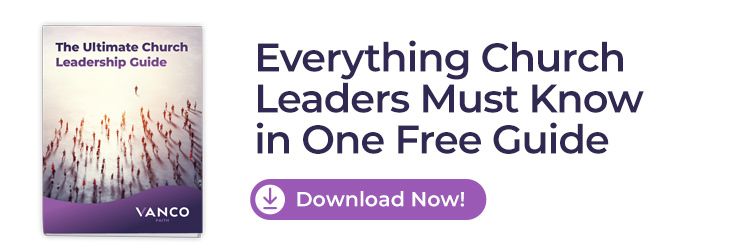
When pastors, congregational leaders and staff embark upon their roles of leading their flocks, few think about church marketing strategies. Marketing for church isn’t what drove them to their faith, and it doesn’t inspire them.
And that’s okay, but just because it isn’t a passion doesn’t mean marketing a church for growth isn't a necessary component for a congregation’s longevity. To sustain itself, your ministry needs to attract new church members.
The lack of growth continues to be a problem for many churches across the country. Churches can no longer expect new members to trickle in. In fact, it will likely get harder for many churches. From 2000 to 2020, Gallup tracked a 22% decline in church membership in Americans, the numbers falling from 69% to 47%.
But there’s good news — 87% of people in the U.S. still believe in God or a universal spirit (Gallup). This means there is a large pool of people still interested in connecting to faith. Churches just need to be a little savvier about drawing new members, and that’s where online church marketing strategies come into play.
Because marketing a church for growth can be cumbersome and tricky to get a start on, we built a comprehensive guide that covers all the online church marketing strategies you need to know. Use this resource, packed with key Christian marketing strategies and church advertising ideas, to guide your leadership and staff in your pursuit of congregational growth.
Table of Contents
Free (Or Inexpensive) Church Marketing Strategies
3) Local Marketing for Churches
6) Social Media for Church Marketing
8) Church Marketing Volunteers
9) Worship Livestreams and Recorded Services
14) Creating a Church Hospitality Ministry
18) Direct Mail Advertising for Churches
19) Hiring an Agency for Christian Marketing Services
20) Using Church Outreach Tools for Events
Bonus Strategy: Three Easy Steps to Boost Funding for Church Marketing Programs
Free (Or Inexpensive) Church Marketing
Are you looking to promote church events without spending big? Marketing your church for growth doesn’t always have to cost a lot of money. In many cases, there are even free church marketing opportunities. These opportunities range from free digital marketing message for churches to more traditional means of marketing. Here are just a few strategies you should consider adding to your church marketing, and communications plan.
1. Church Website
This vital church marketing tool usually isn’t free, but it’s inexpensive, and you’ll need it if you want to access some other free marketing message ideas for churches online. Many of the free platforms out there, such as the Google Ad Grants program that offers ministries $120,000 each year in church advertisements, require a website and church website visitors.
If you don’t have a church website or online presence or are thinking about switching to a more cost-effective and easy-to-use option, here are a few suggestions to consider.
Google, the Free Website for Church Marketing
If you’re looking for a free website to market your church service, Google delivers. With Google, you can create a free, one-page website.
The process of building a Google website can be completed easily in 30 minutes. Most of the work is filling in the Google template with your unique copy.
There are drawbacks to the free Google website. Unless you pay for a domain name, you won’t be able to choose your domain name and URL. Although the budget for digital church marketing efforts is limited for many ministries, it’s best to consider one of the inexpensive paid options we cover below. Like Google, these options are easy to use and most offer intuitive templates that make development so simple anyone can do it.
Wix
For ministries looking to grow their church marketing without hiring a developer, Wix is a great solution. Wix uses a series of premade templates that you can select and edit to fit your church’s needs. Editing these templates can be as simple as dragging and dropping your church’s unique content into its modules.
Building a website with Wix doesn’t cost a thing, but it does charge for hosting the website and for your website’s domain name. Hosting and a domain name are two expenses your church will pay anyway, so Wix is a great deal for churches. The monthly charge for Wix ranges from $14 to $39. For a majority of ministries looking to get started with their church marketing strategies, the cheapest plans will work fine. You can always upgrade later if you need to.
Squarespace
Like Wix, Squarespace uses premade templates to make building a website for marketing a church service easy. The process can be done in a few minutes, as this video demonstrates. Building your website on Squarespace is free, but like Wix, it charges you for a domain and hosting. The cost is comparable to Wix, so it really comes down to preference.
Wix and Squarespace make domain and server setup easy. Normally the process can be tricky, requiring IT knowledge or help, but with Wix and Squarespace, the setup is completed for you automatically.
WordPress
According to Manaferra, 43.2% of websites use WordPress.
WordPress is popular because it is open source, meaning that rather than developing code to perform web functions yourself, you can simply use code somebody else developed on your website.
The process of setting up a WordPress website for your church marketing is easy. Because WordPress is used in most businesses, somebody in your congregation has probably built and managed a WordPress website. If they’re willing to help, WordPress might be a good option.
Wix and Squarespace have more limitations than WordPress. Through WordPress plug-ins, which only take a minute to download and set up in most cases, you can program a website to perform all sorts of complicated functions without coding knowledge.
Managing a WordPress website requires more work because of its relative complexity compared to drag-and-drop builders, such as Wix and Squarespace. Wix and Squarespace were designed to be very low-maintenance and easy to use, so somebody with little to no experience can manage them without help.
2. Website SEO
Search engine optimization (SEO) allows ministries to get their sites in front of individuals without paying for online church advertising or traditional advertising.
Google, Yahoo and Bing are all search engines. Google, the most popular search engine in the U.S., has hundreds of ranking factors that decide the order of their search results.
Understanding these ranking factors is a whole profession, but for church marketing efforts, understanding a few of them will go a long way.
Title Tag
You might not know what a title tag is, but chances are you’ve seen them before. Whenever you search for a term in a search engine, you’ll see several results, all with hyperlinked titles. These are title tags.
In the example below, we typed “Vanco Faith” into our search. The two results that appear in the screenshot each have unique title tags for the pages they lead to.
“Online Giving for Churches | Donation Software & App – Vanco" is the text we set as the title tag for our main faith product page, vancopayments.com/egiving. In the example below, that result is the title tag we set for our home page.
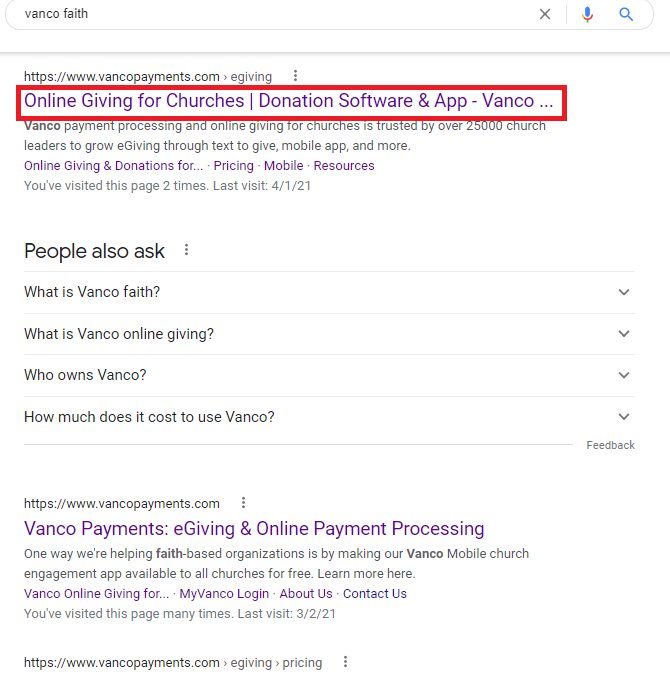
The title tag is easy to edit. It can be edited from your content management system (CMS) by navigating to the page and selecting edit.
Title tags matter to church marketing because Google uses them as a key input to determine what your page is about. This makes it one of the top ranking factors.
When constructing a title tag, make sure you use a term that describes your ministry. Use keywords that people use to search for churches. One church marketing strategy for SEO is to stick to the following format: [Location] Church - [Church Name]. For example, if your church is in Minneapolis, you could use Minneapolis, MN Church – Vanco Valley Congregation as the title tag for your home page.
If you can make your church sound compelling in the title tag text you use, that can help your rankings as well. If your search result has a high click rate, Google and other search engines will give you better rankings.
The last thing to keep in mind when creating a title tag is length. The length of your title tag matters because Google and other search engines will truncate it or cut it off when it’s too long. That’s why the title tag we highlighted in our screenshot has an ellipsis (...) at the end of it.
If your title tags have ellipses at the end, it isn’t necessarily a problem. However, if Google cuts your title tag off in a strange spot, your title might read poorly. This will affect your click rate and your position in the search results. For this reason, make sure you don’t exceed 65 characters in your title tags. In many cases, Google might truncate your text before 65 characters, but at 65 characters truncation is almost certain.
If you’re interested in diving deeper into this tactic for Christian church marketing, Search Engine Journal gives great insights on SEO and title tag optimization. Or, if you’re looking for a video with church marketing tips for title tags, we built a free video guide complete with resources that shows how it can be done in as little as five minutes.
Meta Description
A meta description is a digital church marketing tool your ministry should use, especially because many churches forget to add one for their pages.
If you’re unsure what a meta description is, you’re not alone. However, like the title tag, you’ve likely seen them on countless occasions.
When you enter a search term in a search engine like Google, you’ll get a set of results. All the results have a title and a description. The meta description is what appears under the title.
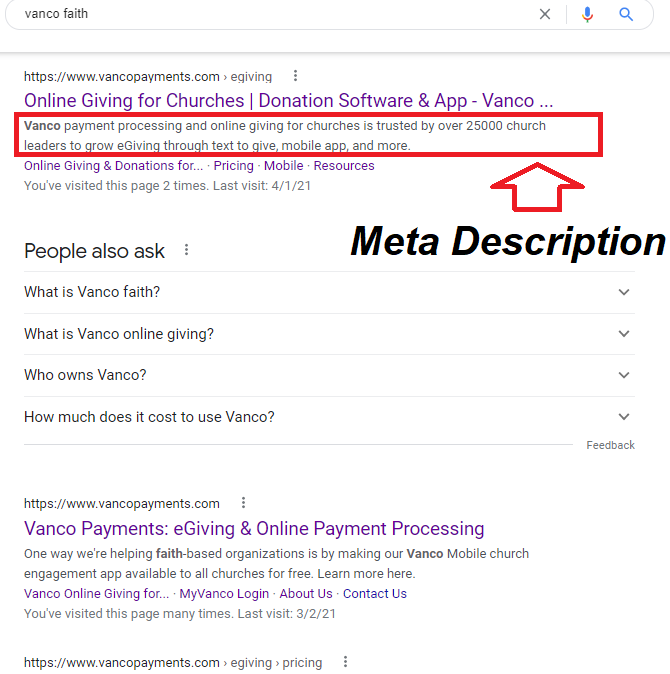
Unlike the title tag, Google doesn’t use the text as one of its direct ranking factors, but it does use the click rates of each result to determine rankings. Your meta descriptions, if compelling, can encourage more people to click on your pages.
By having a meta description that is persuasive, your church’s marketing can enjoy a boost in free traffic. If you don’t include a meta description for a page, Google’s robots will create one for you. Unfortunately, the text the robots pull from your website can look a little like Mad Libs with odd and unrelated text that gets fused together.
If you’re looking to dive deeper into this church marketing strategy, check out this guide for more best practices.
URL
The URL for each webpage you set matters. If that URL includes the keywords searchers in your area use, it will have a greater chance of ranking for those terms. The reason is that search engines like Google use the text in URLs to determine what a page is about.
You can encourage the robots to show your pages high in their results for a certain term if you use it in your URL. For example, let’s say we wanted to give the webpage below a chance to rank when individuals type “church advertising campaigns.” It would help the page rank if we included those three words in the URL.
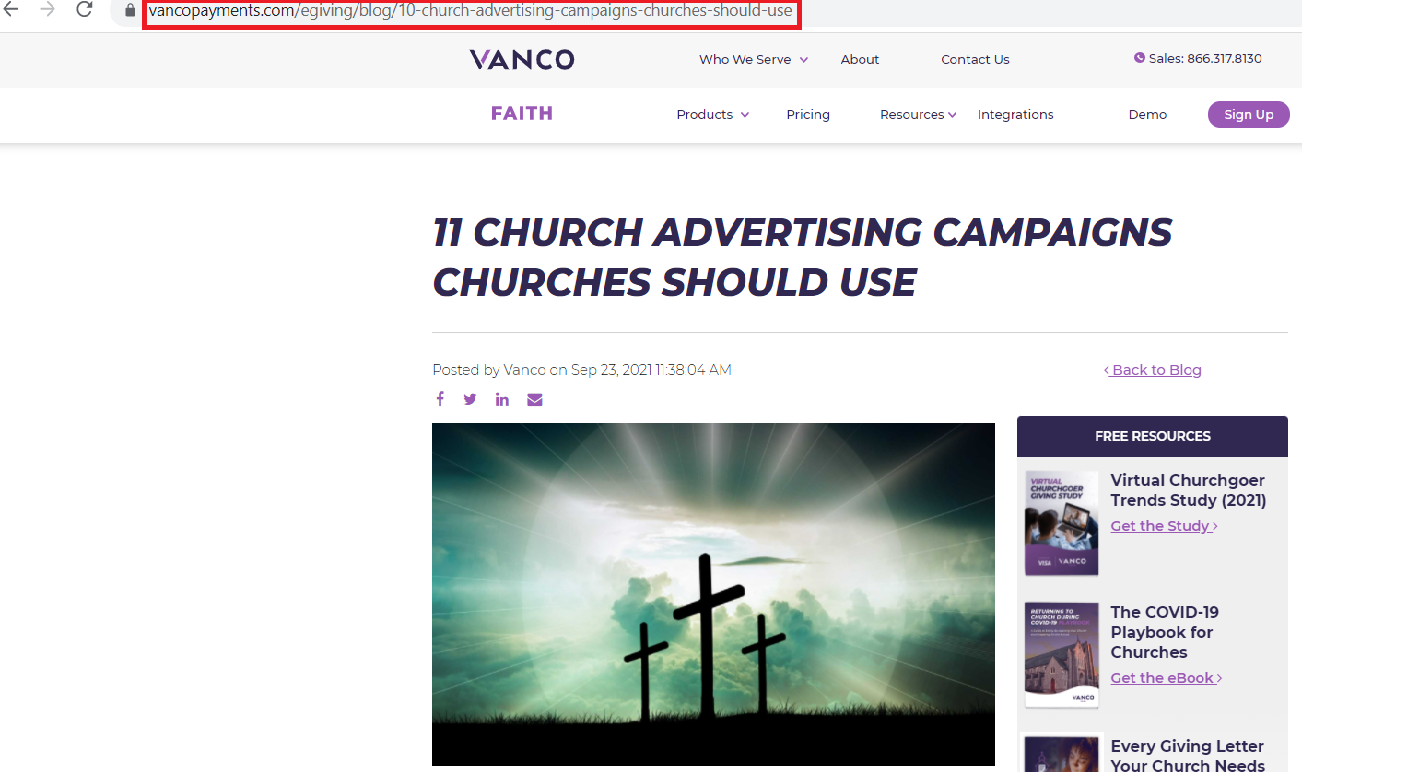
Headers
While reading this piece, you might have noticed the various subheadings sprinkled throughout the blocks of text. Creating these headers is a best practice when it comes to digital marketing for churches. They break up the text, making it easier for readers to skim it and find what they want, and they help the robots that determine search engine rankings.
When Google’s robots crawl your page, they look for keywords to help them determine your page’s relevance to related topics. If your page focuses on a certain topic and uses the phrases associated with it throughout, the page will have a strong chance of ranking.
By placing keywords and phrases in your headers and breaking up the text, you’ll improve your odds of increasing traffic.
If you’re looking to master this church marketing strategy, this guide outlines just a few of the rules you should follow when it comes to crafting headers.
3) Local Marketing for Churches

Church advertising can be expensive and unattainable for many smaller churches. That’s why so many ministries turn to local church marketing to promote themselves. Local marketing is free or inexpensive and makes it easier for ministries of all sizes to enjoy more immediate impact.
By using local church marketing strategies, you can drive more people to your website or online presence, where you can encourage them to view recordings of your sermons, join your missions, check out your events and even participate in your fundraisers.
Putting Your Church on the Map
To start your local church marketing journey, you need to get your church on the map, or in this case, the maps.
Chances are you’ve used Google Maps, Apple Maps or even Waze to find your way around town. Individuals in larger cities or who are new to the community rely on these maps to help them get where they are going and inform them about what amenities are available in town.
It can even help locals learn about new locations, such as a new church opening its doors a few blocks away.
Getting on these maps is free and easy. Here are the instructions for how to get on four of the top business sites your church should claim space on.
Of the four map listings, the most important is Google. Google places its maps at the top of the search engine results page for local searches. By claiming your Google Maps listing, you can get your church to appear above the regular search results.
For example, if you type “Church near me” in Google while in Duluth, MN, Google will find the closest churches to your location. For small churches, or church plants looking to branch out into new areas, this church marketing tool is vital.
Ranking in regular search results takes time and work, but claiming a listing with Google Maps takes very little time and effort. The Google Maps listing is also more prominent. In most cases, the map is the only image on a search results page. This increases your chances of getting traffic. 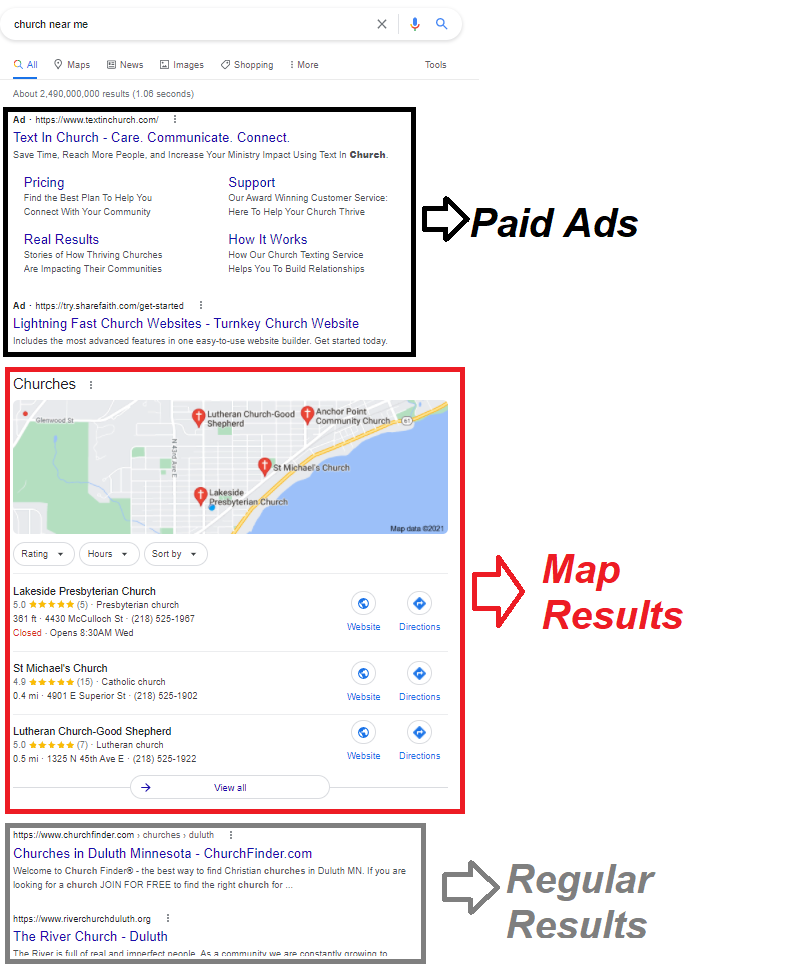
Reviews

The way Google determines map results is a bit different than how it determines its regular search results. One factor that has a major impact on where your church ranks in the map results is reviews. The reason is that users are more attracted to churches with several positive reviews.
Gathering reviews on Google and other important pages like Facebook is a tested church marketing strategy that yields results. Because your congregation is filled with people who have a positive opinion of your church, getting reviews is simple.
Although it might feel uncomfortable, the best way to collect these reviews is to ask. How and where you ask is up to you, but you can place callouts on your materials, such as church bulletin boards, newsletters, church bulletins and other media.
When placing callouts on this media, give instructions on where to leave reviews, such as Google and Facebook, and how to leave reviews.
If you’re looking to include a callout on your website to guide individuals as they leave reviews, provide members and guests with direct links. Follow these steps to get the direct review link for your church on Google and these steps for Facebook.
Citations for Local Church Marketing
As we mentioned earlier, digital marketing for churches works differently on the local level. Local searches require up-to-date location information for the search engine to give users what they’re looking for. For this reason, search engines look for sources that verify the location details of a local organization. These sources are known as citations.
You might not have heard of citations before, but you’ve certainly seen them online. When you search for a particular local business, such as your favorite restaurant, you’ll see results from websites like Yellowpages.com that list location details, reviews and other information.
Having dozens of these citations will help your church appear higher on the list of local searches.
How many citations do you need?
Search engines don’t reveal the secrets of their algorithms, but plenty of organizations spend countless hours studying them. BrightLocal, a marketing service that releases studies on citations, found the average organization with a first-place ranking on Google has 81 citations.
Aside from having many citations, you’ll need them to be consistent. This means the name of your church, phone number and address should be consistent. When this information is not consistent, search engines will push your web pages down in the local search results.
Inconsistent citation information can happen to any church, but it’s most common when churches move locations. The reason for this is that several websites automatically create local listings for your church over time. When your church moves, these sites’ processes don’t notice it for a long time. In some cases, it can take many years for them to correct inaccuracies.
Data Aggregators
How does a ministry interested in local church marketing get citations? There are several ways to do it, but one of the most important is making sure data aggregators have your church’s information.
Most online citations get their local information from one of three companies: Localeze, Infogroup (now Data Axle) and Foursquare.
Once these data aggregators have your information, online listings grab information from the aggregators and create online profiles for your church automatically. For this reason, submitting your information to data aggregators is a low-effort, high-impact church marketing strategy.
Submitting your information to a data aggregator takes just a few minutes. Of the three data aggregators, only two allow organizations to submit information directly. Here are the links to submit your information to them:
If your church has been around for years, your information will likely be in the system for all the data aggregators. However, it is possible that some of this information is incorrect. When the data aggregator has the information wrong, it causes a big problem. Because this information is used by countless sources, over time, the false information is replicated across many citation websites.
That’s why you’ll want to check with the data aggregators and edit any false information. Again, only two of the three data aggregators allow you to update information, Foursquare and Data Axle (formerly Infogroup).
To edit information on each of these aggregators, begin the process the same way as you would to create a new listing. Simply click the links above and enter your church information. Then, instead of clicking to create a new listing, select the listing that appears after searching for your church.
The process of managing citations might seem boring, but it is one of the most effective church marketing strategies you can use. In fact, it might be more valuable than many paid church advertising channels.

Once you finish with the data aggregators, the next local church marketing strategy you’ll want to use is creating a Facebook page if you haven’t done so already. Facebook works as a powerful citation because it is one of the most prominent websites in the world.
Aside from the value of getting your local information on Facebook, a Facebook page offers plenty of other church marketing benefits, including church advertising and social media marketing.
If you haven’t created your account yet, here are instructions for creating a church Facebook page.
How to Get Citations for Local Church Marketing
There are two ways to generate citations: the easy way and the harder way. The easy way to implement this local church marketing strategy is to simply pay someone to do it for you. The harder way is to do it yourself.
The Easy Way
The easy way can be expensive if you’re looking to increase church marketing citations rapidly. However, it isn’t necessary to grab 81 citations all at once.
This is especially true for churches that are established at their locations. If you’re an established church, you will likely have at least a dozen church marketing citations online. Because you already have a head start, you can afford to create fewer citations.
If you’re considering paying for church marketing citations, proceed with caution. Certain citation services charge a yearly subscription to manage citations. If you choose this type of subscription, you’re committed to it for more than a year.
Then once you quit paying for their services, the service will stop sending and managing information sent to citation websites. This can lead to citations reverting to old, outdated information or disappearing altogether.
If you change your church address, there’s no way to directly edit each of the citations created through the service.
The best way to pay for citations is with a one-time fee. Several services do this, such as Whitespark. This service works well because it allows churches to select custom plans where they choose the citation types they prefer.
The Harder Way
We use “harder” instead of “hard” because manually creating profiles isn’t difficult. It involves going to a website and following simple instructions, but it is time-consuming.
If you’re looking to gather local marketing citations for free, it’s good to have a volunteer or group of volunteers. While it will take one person a long time to create dozens of profiles, if you have a half dozen folks helping, the process might only take each person an hour or two.
If you want to improve your local church marketing strategy for free with the help of a few volunteers, divide up a list of citations. You can collect citations from an endless number of websites, but there are a few dozen Google favorites. Here’s a list of 50 of the most prominent.
Collecting a few dozen from this list is a good start for a new church or a church plant. Creating several church marketing citations will spawn even more citations automatically. In many cases, profiles will pull from other profiles even if the original source isn’t a data aggregator.
For established churches, it still helps to create church marketing citations. Adding a few citations from the list of 50 won’t hurt. Your church may be on several of them already if it’s been around for a while, but it’s unlikely to be listed on all of them.
If you and your team are ambitious and eager to get to the 81 citations we mentioned earlier, you can look for business and organizational databases in your area. These websites are a unique value because they collect data from a particular locality or region. Google and other search engines favor these databases over others because they are authorities on their regions and the data they collect is of a higher quality for the specific locations.
SEO Doesn't Need to Be Hard - Free Course to Make It Easy
To make the process easier, we break down how to optimize your church online step by step, and offer free tools to help. We've seen several churches use processes like these. It hardly costs anything to run. In fact, if you already have a website with hosting and a domain name, then you really don't need to spend an extra cent.
We're giving it all away for free because we've made it our mission to help churches grow their communities and thrive.
Get the Free SEO Course Complete with 28+ Free Tools!
Within 55 Minutes, You Can Go from Beginner to Pro Using Low-Cost Techniques Any Church Can Afford!
4. Google Ads for Churches
One high-impact church advertising idea is Google Ads. Google receives more traffic than any other website in the U.S., and its advertisements appear at the top of the results.
You might not think you have the budget to run Google Ads for your missions, but almost any church can do it for free. That’s right. Church marketing doesn’t cost a thing on Google Ads! All you must do is meet the requirements of their Google Ad Grants program.
Once you meet the requirements, your church will receive $10,000 each month to spend on Google Ads. If you’re wondering how to qualify and get the most out of the program, we built a comprehensive guide. Get our Google Ad Grants for Churches Guide free.
5. YouTube for Churches
Your ministry might already be using YouTube for your church, especially if you’re livestreaming your services on the channel or showing recordings of them.
However, you can use YouTube for church advertising and it won’t cost you a thing. If you qualify for the Google for Nonprofits program, you can advertise on YouTube for free. If you want to know more about the requirements for qualifying, check out our Google Ad Grants for Churches Guide in the previous section. In the guide, we detail the requirements and steps for applying.
Once you qualify, you can start creating church marketing videos on YouTube. For some handy tips on using the program, check out this free guide from Classy.
6. Social Media for Church Marketing
Many ministries use a social media presence as a component of their overall church marketing strategies. Because social media platforms, such as Facebook, count users in the billions, churches can reach members and newcomers with ease. This is why social media marketing and advertising works so well.
Ensure your church is on the most prominent social media channels. In the U.S., the two most important are Facebook and Instagram. Almost 2 billion people use Facebook each day. This makes it an important way to inform members of new events while helping those in your community learn about your church.
Instagram
Although Facebook is a great channel when it comes to digital marketing for churches, it has some drawbacks. Younger generations use Facebook less often, which is why you’ll want to use Instagram as well.
The two are similar, especially since Facebook acquired Instagram in 2012, but the more image-heavy Instagram attracts younger users at a greater clip. If you haven’t set up an account yet, here are instructions on how to set up a church Instagram page.
Once you set up your page, you’ll want to dive a little deeper into execution. Because there’s a little bit of a learning curve for ministries new to this platform, we built a free Church Instagram Strategy Guide to help.
Using Free AI Prompts to Create Social Media Content
There's just no away around it, creating social media content takes time, which is in short supply for many churches. Fortunately, with the latest advancements in AI, you can quickly create customized social media content to engage users with free advanced prompts. Check out the video below to see how it can be done for free and with ease.
Social Media Policy
Before creating a social media strategy for your church, it’s good to establish a few ground rules. Even if you’ve already started your social media programs, you’ll still want to take a moment to settle on a few policies.
Creating social media policies can help your church avoid falling prey to the divisiveness that social media can cause. It can also help members engage on church social media pages in a healthy way.
7. Church Events and Fundraisers

Many looking to join a church want to be a part of something bigger than themselves. Church fundraisers and events are great ways to draw attention to your church because they can inspire outsiders to join your cause.
Although creating and planning fundraisers and events can be time-consuming, it’s important for churches interested in growth to create a busy calendar filled with them.
If you’re not sure what fundraisers or events to try, look at what other congregations in your region have done. Or, if you’re part of a larger denomination, ask for advice from other pastors. You can also check out this list of tested church fundraisers our team created.
Whatever you decide when it comes to fundraisers and events, make sure they are integrated into your larger church marketing plan. Make sure you include callouts to important church activities and provide resources to help newcomers get involved.
Following a few marketing for church and affordable event promotion principles for churches can go a long way in helping your ministry reach its goals.
8. Church Advertising and Marketing Volunteers

Your church is an important part of the lives of many people. These people want your church to succeed, because it is a spiritual rock for them and their community. Seek church marketing help from your congregation to gather a volunteer or team of volunteers. Don’t leave all this work up to your pastor, staff and church leaders.
The church marketing strategies covered in this guide work for more than just the faith and church community. Creating volunteer opportunities for younger members, especially those who are looking to start careers in business, can give them an advantage when they apply for work.
You can make a big impact on the lives of one or more of your members by creating volunteer opportunities that help them and your church.
Promoting your volunteer opportunities to the congregation is easy. You can include callouts in your newsletters, church announcements, bulletins and your pastor can even mention them from the pulpit.
When framing your volunteer opportunities, mention both the benefits to the volunteers and to the church. This will create more enthusiasm for volunteering.
If your church is unable to find volunteers from your congregation, you can seek outside help. Websites like Catchafire will pair your church with volunteers who are interested in helping organizations like yours.
If you go this route, make sure you ask your volunteers to take notes on their activities. This will ease the transition of the work when the volunteer opportunities end.
Church Marketing Content
 Whether you’re looking into the free marketing ideas for churches or some of the paid church advertising ideas, you’ll need content to promote.
Whether you’re looking into the free marketing ideas for churches or some of the paid church advertising ideas, you’ll need content to promote.
Creating content to use for church marketing might seem like an arduous task but it doesn’t have to be, especially with all the content your church creates on a weekly basis.
By pulling from this content or reusing it, you can create interest in your church, its missions and its events. In fact, this is something we've talked about a lot because it is so important. One thing many churches miss is how easy this can be for them. In this video we outline how to create a year's worth of content in a single day.
Looking for more content ideas? Here are just a few types of content your church could use to spread the word.
9. Worship Livestreams and Recorded Services
Each week, your pastor spends hours preparing an engaging sermon that moves your members. Why not use these recordings in social media posts, ads, blogs or even podcasts?
10. Church Podcasts
If you’ve already gone through the trouble of streaming and recording services for your virtual audiences each week, it won’t be much harder to create a church podcast of your weekly sermons. You can then promote your weekly sermons on several church marketing channels to gain interest.
11. Church Blogs
You can also create blogs by summarizing your weekly church sermons. This new content will increase the free web traffic to your website. You can even embed video recordings of your sermons in your blog to boost its efficacy.
Blogs with embedded videos gain more user engagement, which is important. How often a user engages with a certain page is a major factor in determining how well it ranks in search results.
Just make sure you include a 300- to 500-word summary of each sermon recording. You need this text with the video because the robots that crawl the blog and determine where to rank the page need words to understand what it is about.
By including at least 300 words with your video in the blog, you give the robots enough context to determine what the video is about. Once the robots understand what your page is about, your content will have a stronger chance of ranking.
Although this church marketing strategy can take time, it can pay off. Creating more content expands the reach of your website and boosts other pages in your domain.
12. Newsletters
For many ministries, newsletters are an integral part of their overall church marketing strategies. Some even promote their newsletters in their church advertising.
If you haven’t started a church newsletter or are looking to improve it, there are many tested techniques you can use. In our free Church Newsletter Guide, we outline where you can find free templates, amazing examples, best practices and much more. We also outline how to use AI for free to create newsletter content quickly. You can find the process in the video guide below.
Free Graphics
When you publish church marketing content, either physical or an online presence, you can enhance it and draw more attention to it with all kinds of free designs and graphics.
For example, you can use Canva, a free-to-use online graphic design tool, to create social media posts, presentations, posters, videos, logos and much more. Check out sites such as Unsplash, Pixabay, Pexels and others that provide free stock photos and images.
13. Welcome Materials
An important part of growing your congregation is connecting with new and different individuals and families in your community. Once an individual or family joins your church, you need engaging and attractive welcome materials to introduce the church to them.
Church welcome packets are a must. Use our free resource, Welcome Materials to Turn Visitors into Members, which includes welcome and feedback cards, a welcome verse and quote card template, welcome message templates, church volunteer cards and more.
14. Creating a Church Hospitality Ministry
The fact is that most new visitors never become new members, because most churches don't have a team or a plan to convert them. Our Free Church Hospitality Ministry Guide explains why establishing a hospitality ministry is important and provides valuable information on how to plan a ministry, who should be involved and how to run it. You’ll also get ideas on great ways to attract new members.
Paid Church Advertising
 How do churches advertise? There are paid channels and there are free channels. We covered many of the free marketing ideas for churches in previous sections.
How do churches advertise? There are paid channels and there are free channels. We covered many of the free marketing ideas for churches in previous sections.
Now, it’s time to focus on paid church advertising ideas. Incorporate these channels into your church marketing plan to get an extra boost.
15. Facebook Ads

We mentioned Facebook earlier, but because it is so important to a church marketing strategy, we’re mentioning it again. Many churches already promote themselves on Facebook, but Facebook limits the reach of your posts. Even your members might not see church updates on their newsfeeds.
That’s why a growing number of churches are turning to Facebook Ads to boost their church marketing. Because Facebook allows detailed targeting that can help your ministry zero in on the perfect target audience, it is a great church advertising tool.
Before you embark on your Facebook Ad journey, you should educate yourself on the nuances of using the platform. There can be a slight learning curve to get up to speed, which is why we built a comprehensive Facebook for Churches Guide. The guide covers all the specifics you need to know including tracking, campaign setup, optimization and much more.
16. Newspaper Ads

We’ve focused on plenty of digital church marketing and advertising platforms, but don’t overlook some old-fashioned platforms. Church marketing in local newspapers works.
Many members and individuals in your community know and trust the local paper. That’s why placing an ad in it can be a good idea.
Before you create a church advertisement in your local paper, you should understand your options. Many newspapers offer free ad design or creative support. Although the idea of free design help sounds great, in most cases, it isn’t what it’s cracked up to be.
Many of the ads these newspapers create won’t stand out, and what good is your church advertisement if it doesn’t stand out?
Because your church has many members who are invested in your church’s growth, it’s better to get the ad dimensions and specs from the newspaper and submit your own ad. Let your members volunteer to create an advertisement. Many will have experience with the programs needed to design an advertisement, and they will likely enjoy creating visual artwork that represents their church.
17. Signage

Some church marketing options never sleep, working around the clock to announce your church’s presence to the world. You can get 24/7 church marketing with signage.
Having visible signage and space for a message on your sign can help people passing by recognize your church. It can also help them become aware of your upcoming events and fundraisers, making it one of your most valuable church marketing tools.
18. Direct Mail Advertising for Churches

If your church is new to an area or simply looking to get the word out about a local fundraiser, direct mail might be a good option. Direct mail is one of the cheapest church marketing strategies you can use, and it has been a staple of church marketing for decades.
The United States Postal Service (USPS) makes the process of sending postcards and mailers easy with their Every Door Direct Mail (EDDM) service. Using the EDDM service, you can send church marketing materials to the nearest USPS location to be mailed.
The EDDM program site offers guides for imagery and the price per piece. You can also save money on church marketing with the program by using its tools to zero in on certain demographics.
19. Christian Marketing Services Agencies
Your ministry could look for Christian marketing services and hire a church advertising agency, but it will add significantly to your costs.
Advertising for a church can be done cost-effectively using volunteers and nonprofit programs, so you should hesitate before hiring a church advertising agency. They might help produce better results, but there are plenty of drawbacks.
One of the biggest drawbacks to hiring Christian marketing services is the technical jargon they use. If you don’t understand the church advertising platforms they’re using, they could be bending the truth about the efficacy of their results.
For this reason, it is a good idea to at least educate yourself about the platforms or ask a member of your congregation who has experience with managing ads. They will be able to better assess the performance of your Christian marketing services. This will help you address any issues the agency might have missed.
Church Outreach
 Church outreach helps you strengthen the bonds among church members and connect with potential new members and nonmembers in your local community. Outreach projects engage the outside community and increase local recognition of your church and the good work you do.
Church outreach helps you strengthen the bonds among church members and connect with potential new members and nonmembers in your local community. Outreach projects engage the outside community and increase local recognition of your church and the good work you do.
20. Church Outreach Tools for Events
To help you plan and run church outreach events, check out our blogs on Effective Church Outreach Ideas and an Event Planning Worksheet and How-To's.
Bonus: Three Easy Steps to Boost Funding for Church Marketing Programs
And finally, here are three steps 26,000 churches have taken to increase donations by an average of 26%.
- Request a demo to see our tools in action and have one of our experts guide you to the best set of tools for your church.
- Launch and don’t worry. You don’t need to be tech-savvy to implement our programs. They are easy to use, and we have 24/7 support to help your church reach its goals.
- Enjoy an increase in donations!
FAQs
How can churches utilize social media platforms to enhance their outreach?
Social media platforms can be utilized by creating engaging content, sharing updates and events and interacting with the congregation and community. Platforms like Facebook, Instagram and Twitter can be used to share inspirational messages, livestream services, promote community events and encourage members to share their experiences and invite others to join. By utilizing social media platforms effectively, churches can reach a wider target audience, build relationships and foster a sense of community.
What role does a church website play in the overall marketing strategy?
A church website plays a crucial role in the overall marketing strategy as it serves as a central hub for information, resources and engagement. It provides a platform for churches to share their mission, values and beliefs, showcase their ministries and programs and provide information about upcoming events and services. A well-designed and user-friendly website can attract new visitors, engage current members and serve as a tool for online giving, event registration and communication. It also allows churches to reach a global audience and extend their outreach beyond physical boundaries.
How can I use AI to streamline marketing and other tasks?
AI is a huge time saver. It also can expand your capacity and improve each of your outputs. This is huge for churches, who have limited staff. In the video below, we demonstrate free processes you can use to expand your output significantly, helping you to grow your church.
Are there specific trends in church marketing that should be considered?
Specific trends in church marketing that should be considered include the increasing importance of online presence and digital engagement, the rise of livestreaming and virtual events, the use of targeted social media advertising and the integration of technology for seamless giving and communication. Churches should also focus on creating personalized and authentic content, leveraging storytelling and testimonials and prioritizing community engagement and outreach. Staying up-to-date with emerging technologies and platforms, such as virtual reality and augmented reality, can also be beneficial in reaching and engaging the younger generation.
How can churches engage with the local community through marketing efforts?
Churches can engage with the local community through marketing efforts by actively participating in community events, partnering with local organizations and businesses and organizing outreach programs. They can also leverage social media platforms and local advertising channels to promote their involvement in community initiatives, share stories of impact and invite community members to participate in church activities. Building relationships with local media outlets and utilizing public relations strategies can also help churches gain online visibility and connect with the local community.
What tools or technologies are recommended for church marketing in the current landscape?
Recommended tools and technologies for church marketing in the current landscape include social media management platforms, email marketing software, website builders, online giving platforms, livestreaming tools and customer relationship management (CRM) systems. These tools can help churches streamline their marketing efforts, manage their online presence, automate communication, track engagement and donations and analyze data for informed decision-making. It is important for churches to choose tools that align with their specific needs and goals, and to regularly evaluate and adapt their technology stack as new innovations emerge.
How can churches measure the effectiveness of their marketing strategies and adjust accordingly?
Churches can measure the effectiveness of their marketing strategies by setting clear goals and key performance indicators (KPIs), tracking website analytics, monitoring social media engagement and reach, conducting surveys and feedback sessions and analyzing donation and attendance data. By regularly reviewing and analyzing these metrics, churches can identify areas of success and areas for improvement and make data-driven decisions to adjust their marketing strategies accordingly. It is important to establish a feedback loop and continuously evaluate the impact of marketing efforts to ensure they align with the church's mission and objectives.





